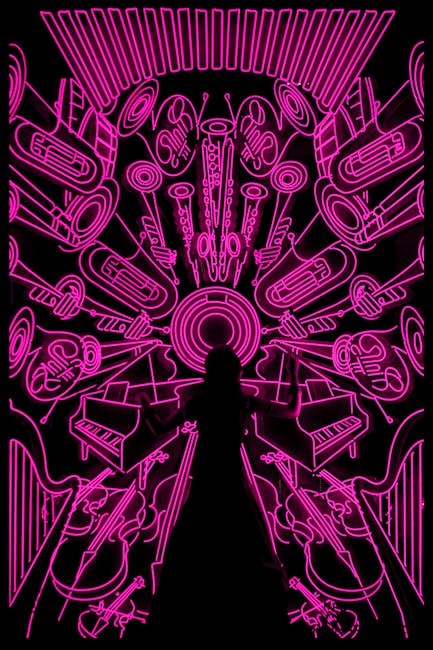Composed in 1924 by Launy Grøndahl, the Trombone Concerto is a significant work in classical music, inspired by the trombone section. Available as PDF, it remains popular among trombonists.
Overview of the Concerto
Launy Grøndahl’s Trombone Concerto, composed in 1924, is a cornerstone of trombone repertoire. Inspired by the trombone section, it premiered in Copenhagen with Vilhelm Aarkrogh. Scored for solo trombone and orchestra, the concerto is known for its lyrical and technical demands. Available as a PDF, it includes arrangements for trombone and piano or orchestra. Its availability in critical editions and public domain status in Canada and the U.S. enhances accessibility for performers and educators worldwide.
Significance of the Grøndahl Trombone Concerto in Classical Music
Launy Grøndahl’s Trombone Concerto, composed in 1924, is a cornerstone of trombone repertoire, celebrated for its lyrical melodies and technical brilliance. It remains one of the most popular and technically challenging works for trombonists, inspiring generations. The concerto’s widespread performance and study highlight its enduring influence. Available in PDF formats, it is easily accessible to musicians, educators, and students, ensuring its continued relevance in classical music education and performance.
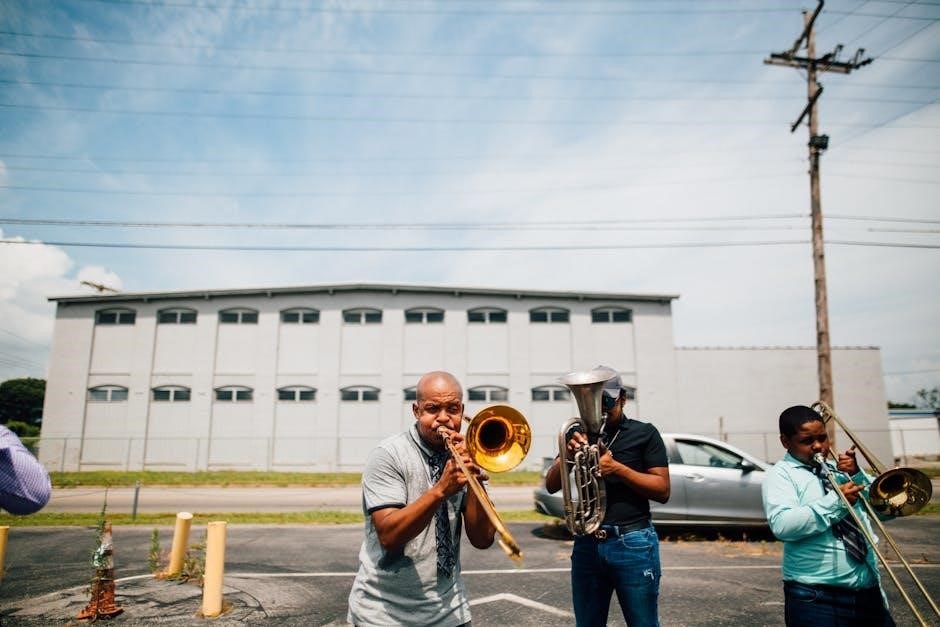
Background of the Composer
Launy Grøndahl, a Danish composer, wrote the Trombone Concerto in 1924, significantly impacting classical music. His work remains widely performed and studied, available as PDFs for global access.
Launy Grøndahl: A Brief Biography
Launy Grøndahl, a prominent Danish composer, was born in 1886 and passed away in 1960. Known for his contributions to classical music, he composed the celebrated Trombone Concerto in 1924. This work, inspired during his time in Italy, highlights his mastery of orchestration and melodic writing. Grøndahl’s compositions are still widely performed and studied, with the concerto being a cornerstone of trombone repertoire. His legacy endures through his music, available in PDF formats for modern musicians.
Grøndahl’s Contributions to Trombone Repertoire
Launy Grøndahl’s Trombone Concerto, composed in 1924, stands as a landmark in trombone literature. It elevated the trombone’s role in classical music, showcasing its expressive and technical capabilities. The concerto’s lush melodies and challenging passages have made it a cornerstone of trombone repertoire. Its availability in PDF formats ensures accessibility for modern musicians, solidifying Grøndahl’s enduring influence on trombone music and education. This work remains a testament to his innovative approach and lasting impact on the instrument’s artistic development.
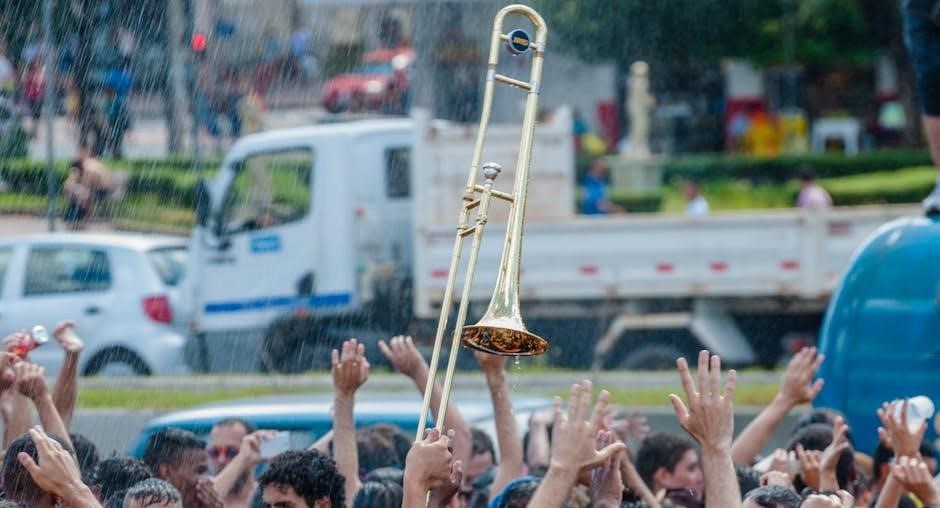
Composition Details
Composed in 1924, the concerto premiered in Copenhagen with Vilhelm Aarkrogh. Grøndahl wrote it during his time in Italy, blending Nordic and Italian influences effectively.
Year of Composition and Premiere
Launy Grøndahl’s Trombone Concerto was composed in 1924 during his time in Italy, where he drew inspiration from the vibrant musical scene. The premiere took place in Copenhagen, featuring trombonist Vilhelm Aarkrogh and the Casino Theatre Orchestra. This debut marked the concerto’s entry into the classical repertoire, showcasing its blend of Nordic elegance and Italian flair. The piece quickly gained recognition for its technical demands and lyrical qualities, establishing it as a cornerstone of trombone literature.
Inspirations Behind the Concerto
Launy Grøndahl’s Trombone Concerto was inspired by the trombone section during his time in Italy, where he was captivated by the instrument’s expressive qualities. The work reflects his deep appreciation for the trombone’s nobility and grandeur, blending Nordic Romanticism with Italian musical influences. Grøndahl’s personal connection to the instrument and its players, such as Vilhelm Aarkrogh, further fueled his creativity, resulting in a concerto that highlights the trombone’s technical and emotional range.
Structure of the Concerto
The Grøndahl Trombone Concerto is structured in three movements: Allegro, Andante, and Allegro. Each movement showcases the trombone’s technical and expressive capabilities, blending Romanticism with lyrical charm.
First Movement: Allegro
The first movement, marked Allegro, opens with dramatic themes and technical passages, showcasing the trombone’s agility. It features a dynamic interplay between the soloist and orchestra, blending bold statements with lyrical moments. The movement highlights the trombone’s ability to project both power and nuance, setting a vibrant tone for the concerto. Its structure balances Classical form with Romantic expressiveness, making it a cornerstone of trombone repertoire.
Second Movement: Andante
The Andante movement is a lyrical and expressive contrast to the Allegro, showcasing the trombone’s cantabile qualities. It features soaring melodies and rich harmonies, with the soloist delivering heartfelt phrases. The movement highlights the trombone’s ability to convey deep emotion, supported by subtle orchestral textures. Its introspective nature provides a serene interlude, balancing the concerto’s technical and artistic demands. The Andante is a cornerstone of the work, demonstrating Grøndahl’s mastery of lyrical writing for the trombone.
Third Movement: Allegro
The final Allegro movement is a vibrant and energetic conclusion to the concerto, showcasing virtuosic technique and lively rhythms. The trombone engages in intricate passages, highlighting its agility and clarity. Orchestral accompaniment provides dynamic support, with interplay between the soloist and ensemble. The movement builds toward a climactic finale, demonstrating the trombone’s capabilities in both technical brilliance and musical expression. This movement solidifies the concerto’s reputation as a cornerstone of trombone repertoire, leaving a lasting impression on listeners.
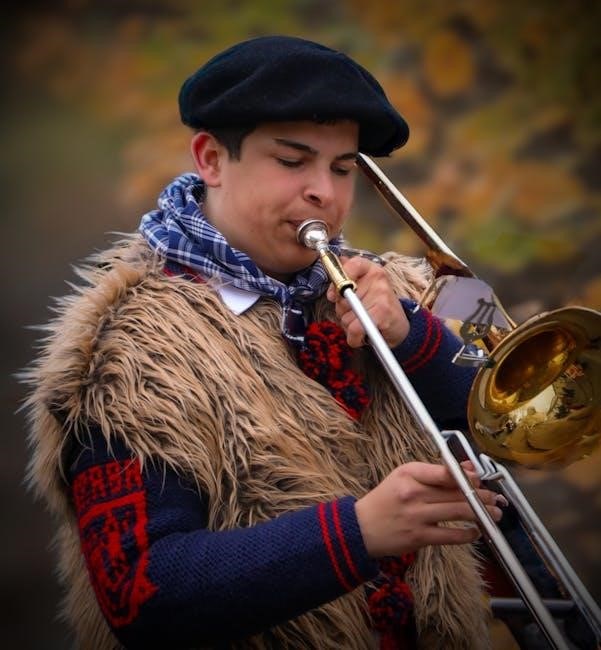
Instrumentation
The Grøndahl Trombone Concerto is scored for solo trombone and orchestra, with an arrangement for trombone and piano available in PDF format for performance and study.
Solo Trombone Requirements
The Grøndahl Trombone Concerto demands exceptional technical and lyrical skills from the soloist. It requires mastery of legato playing, dynamic control, and precise articulation across the instrument’s range. The concerto’s three movements challenge trombonists with intricate passages, high tessitura, and expressive phrasing. Advanced students and professionals often perform this work, as it showcases both technical brilliance and musical depth. The solo trombone part is available in PDF format, allowing for thorough study and preparation for performance.
Orchestral Accompaniment
The Grøndahl Trombone Concerto features a rich orchestral accompaniment that complements the solo trombone. The orchestra includes woodwinds, brass, percussion, and strings, creating a balanced and dynamic interplay. The score is available in PDF format, allowing for detailed study of the orchestral arrangement. Originally premiered by the Orchestra of the Casino Theater, the concerto’s orchestration enhances the soloist’s expression, providing both harmonic support and contrasting textures. This arrangement highlights Grøndahl’s mastery of orchestral writing.
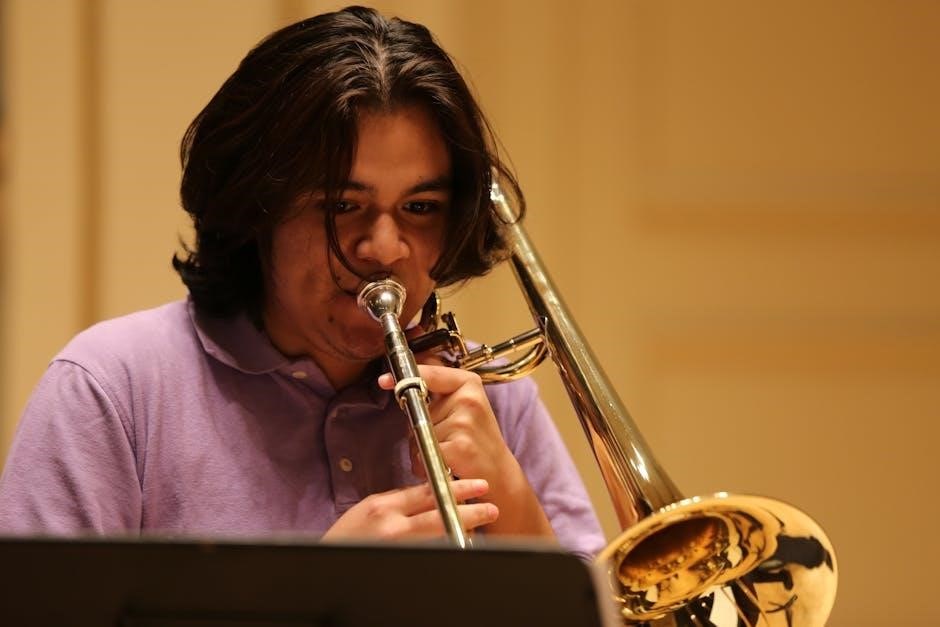
Historical Significance
The Grøndahl Trombone Concerto, composed in 1924, is a groundbreaking work that significantly expanded the trombone repertoire, offering a substantial solo piece and inspiring future compositions.
Impact on Trombone Literature
The Grøndahl Trombone Concerto has profoundly influenced trombone literature, setting a new standard for solo trombone works. Its rich melodies and technical demands have made it a cornerstone of the repertoire, inspiring generations of composers to explore the trombone’s expressive potential. The concerto’s popularity endures, with many regarding it as a defining piece in the trombone’s classical cannon, fostering growth in both composition and performance practices within the musical community.
Popularity Among Trombonists
The Grøndahl Trombone Concerto is a beloved staple in trombone repertoire, cherished for its lyrical melodies and technical challenges. Its widespread popularity stems from its emotional depth and virtuosic demands, making it a favorite for both professional trombonists and students. Performances by notable artists like Megan Gale and Dustin Nguyen highlight its enduring appeal. The concerto’s availability in PDF format has further boosted its accessibility, solidifying its place as a cornerstone of trombone literature and a defining piece for the instrument.
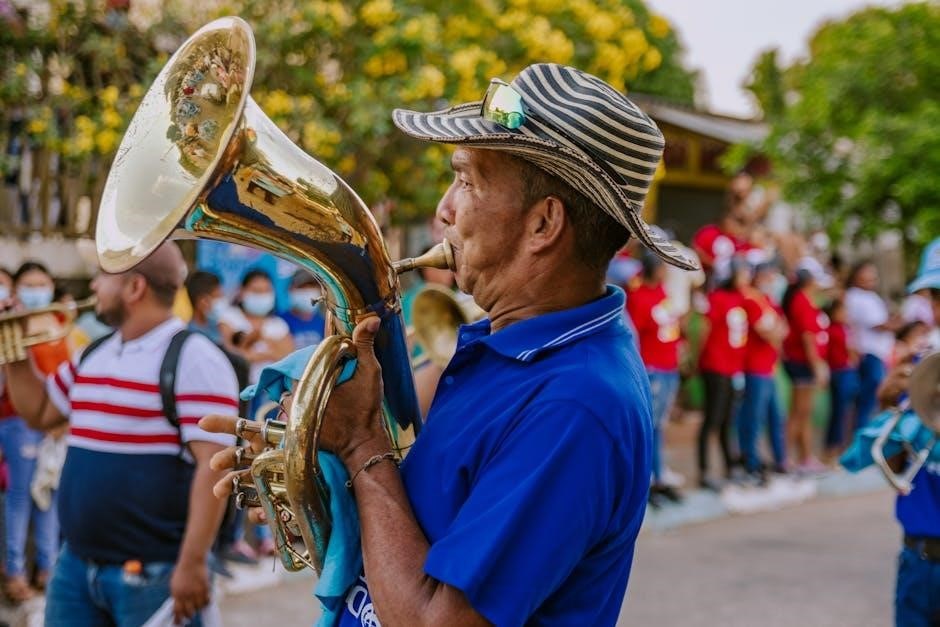
Performance History
Premiered in Copenhagen with Vilhelm Aarkrogh, the concerto has been performed by notable trombonists like Megan Gale and Dustin Nguyen, showcasing its enduring appeal and accessibility in PDF.
Famous Performances and Soloists
The Grøndahl Trombone Concerto has been performed by renowned trombonists, including Megan Gale, who delivered a captivating rendition of the first movement with piano accompaniment. Dustin Nguyen, winner of the Bienen School’s Concerto Competition, also showcased the piece with orchestral arrangement. These performances highlight the concerto’s enduring appeal and its ability to inspire new interpretations. The work’s availability in PDF format has further facilitated its accessibility, allowing artists worldwide to engage with and perform this iconic composition, ensuring its legacy endures in classical music.
Notable Recordings
Notable recordings of the Grøndahl Trombone Concerto include performances by celebrated trombonists such as Megan Gale and Dustin Nguyen. Their interpretations highlight the concerto’s expressive depth and technical brilliance. The work’s availability in PDF format has facilitated its widespread dissemination, enabling musicians and audiences to access and appreciate these recordings. These performances underscore the concerto’s enduring popularity and its significance in classical trombone repertoire, ensuring its continued relevance and admiration in the musical world.
Availability of Sheet Music
The Grøndahl Trombone Concerto is widely available in PDF format for trombone and piano, as well as orchestral scores, making it accessible for musicians and educators worldwide.
PDF Editions for Trombone and Piano
PDF editions of the Grøndahl Trombone Concerto are widely available, offering convenient access for musicians. These editions typically include the trombone solo part and a piano reduction, allowing for practice and performance without an orchestra. Many websites provide free or affordable downloads, making the concerto accessible to students and professionals alike. The PDF format ensures easy portability and printing, facilitating rehearsal and study. This arrangement is particularly useful for recitals, auditions, or when orchestral accompaniment is not feasible, maintaining the work’s musical integrity.
Orchestral Score Availability
The Grøndahl Trombone Concerto’s orchestral score is widely available in PDF format, enabling conductors and ensembles to access the full arrangement. Critical editions, such as those by Poul Ivan Møller, provide detailed orchestral parts. The score is also accessible for free in countries where the work is in the public domain, including Canada and the United States. Platforms like MuseScore offer downloadable versions, making it easy for musicians to obtain and perform the concerto with orchestral accompaniment, ensuring its continued presence in classical music repertoire.
Challenges for Trombonists
The Grøndahl Trombone Concerto presents technical and artistic challenges, requiring precise intonation, phrasing, and expression. Its demanding passages test a trombonist’s skill and musicality, ensuring a captivating performance.
Technical Difficulties in the Concerto
The Grøndahl Trombone Concerto presents significant technical challenges, including rapid passages in the first and third movements. Trombonists must navigate large intervals and sustained melodies, requiring precise intonation and breath control. The concerto demands mastery of both legato and staccato playing, with intricate phrasing and dynamic contrasts. Additionally, the cadenzas and virtuosic sections test the performer’s technical proficiency and musicality, making it a formidable yet rewarding piece for advanced trombonists.
Artistic Interpretation and Expression
The Grøndahl Trombone Concerto offers rich opportunities for artistic interpretation, with its lyrical melodies and dramatic contrasts. Trombonists must balance technical precision with emotional depth, capturing the concerto’s Scandinavian-inspired nuances. The work’s phrasing and dynamic range allow for expressive phrasing, while its harmonic structure invites imaginative storytelling. Players are encouraged to infuse their unique voice into the piece, blending technical mastery with musicality to convey its profound emotional resonance and timeless appeal.
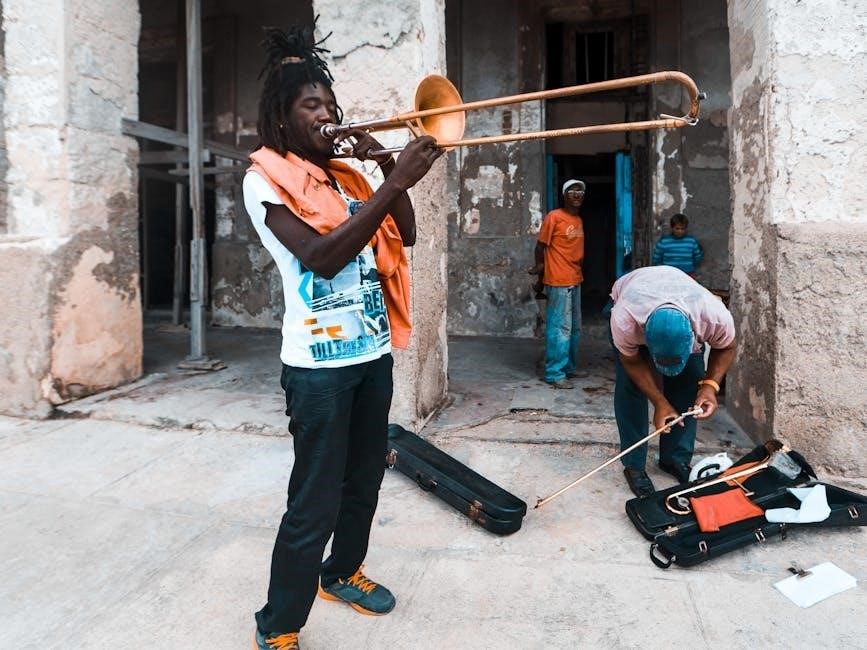
Comparisons with Other Trombone Concertos
The Grøndahl Trombone Concerto is often compared to works by Holst and Parris, yet its Scandinavian-inspired lyrical quality and technical demands set it apart in the repertoire.
Similarities and Differences with Other Works
Grøndahl’s Trombone Concerto shares lyrical qualities with works by Holst and Parris but stands out with its Scandinavian-inspired melodies and balanced technical demands. While it aligns with classical concerto structures, its unique voice and emotional depth differentiate it from other trombone concertos. The concerto’s blend of nobility and grandeur, as noted by many, positions it as a distinctive yet complementary piece within the trombone repertoire, offering both familiarity and innovation to performers and audiences alike.
Grøndahl’s Unique Style
Launy Grøndahl’s Trombone Concerto showcases his unique style through a blend of Scandinavian-inspired melodies and classical concerto structures. Composed in 1924, it reflects his deep appreciation for the trombone’s expressive qualities. The work combines lyrical phrasing with technical demands, creating a balance that highlights both the instrument’s nobility and agility. Premiered by Vilhelm Aarkrogh with the Casino Theatre Orchestra, the concerto’s emotional depth and harmonic richness have made it a cornerstone of trombone repertoire, appealing to both advanced performers and discerning audiences.
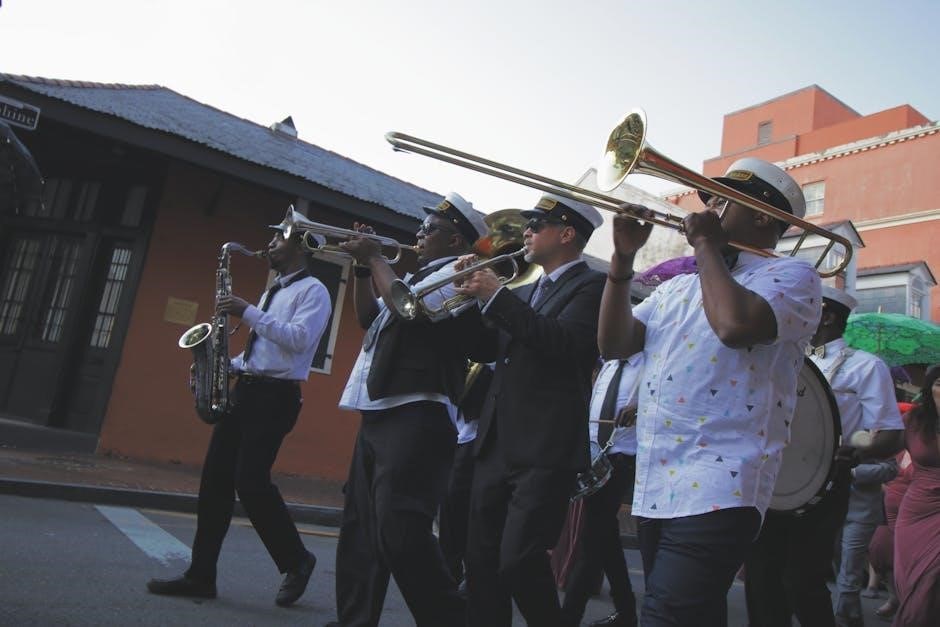
Educational Value
The Grøndahl Trombone Concerto is widely used in music education, offering advanced students a challenging yet rewarding piece to refine technical and artistic skills.
Use in Music Education
The Grøndahl Trombone Concerto is a cornerstone of advanced trombone studies, frequently included in university curricula. Its availability as a PDF makes it accessible for students and educators worldwide. The concerto’s technical and artistic demands provide a comprehensive framework for developing proficiency, while its orchestral score offers insights into ensemble dynamics. Music schools often use it to teach phrasing, tone production, and interpretation. Its inclusion in master’s programs underscores its relevance in classical music education, preparing students for professional performances.
Repertoire for Advanced Students
The Grøndahl Trombone Concerto is widely regarded as essential repertoire for advanced students, offering a blend of technical and artistic challenges. Its availability in PDF format facilitates study and practice, making it a staple in university programs. The concerto’s intricate passages, dynamic range, and expressive demands prepare students for professional performances. It is often featured in recitals and competitions, showcasing a student’s mastery of both lyrical and virtuosic playing. This work remains a cornerstone of trombone education, bridging the gap between academic training and professional artistry.
Cultural Impact
Grøndahl’s Trombone Concerto has significantly enhanced Scandinavian music’s global presence, influencing trombone repertoire and inspiring performances worldwide. Its availability as a PDF fosters accessibility for musicians and educators.
Grøndahl’s Influence on Scandinavian Music
Launy Grøndahl’s Trombone Concerto has profoundly shaped Scandinavian music, elevating the trombone’s role in classical repertoire. His lyrical and rhythmic style bridges Romanticism and modernity, inspiring generations of Nordic composers and musicians. The concerto’s global popularity, facilitated by its availability as a PDF, has cemented Grøndahl’s legacy as a pivotal figure in Scandinavian musical heritage, fostering pride and artistic innovation in the region.
Global Recognition of the Concerto
The Grøndahl Trombone Concerto has garnered global acclaim, becoming a cornerstone of trombone repertoire. Its lyrical melodies and technical challenges resonate with audiences worldwide. Performances span international stages, from Europe to the Americas, showcasing its universal appeal. The concerto’s availability as a PDF has further enhanced its accessibility, making it a favorite among trombonists and educators. Its enduring popularity underscores its significance in classical music, bridging cultural boundaries and inspiring future generations of musicians and music enthusiasts alike.
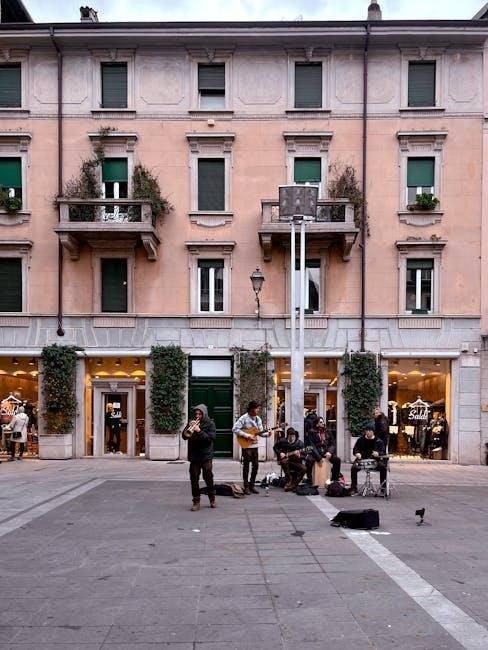
Modern Arrangements
The Grøndahl Trombone Concerto has been arranged for various ensembles, including band, by Poul Ivan Møller, ensuring its relevance in contemporary performances and educational settings.
Arrangements for Different Ensembles
The Grøndahl Trombone Concerto is available in arrangements for various ensembles, including concert bands and brass ensembles, ensuring its accessibility beyond the original orchestral setting. Poul Ivan Møller’s 1984 arrangement for band has been particularly well-received, maintaining the concerto’s original charm while adapting it for different performance contexts. These arrangements have made the work a staple in both professional and educational settings, allowing trombonists to showcase their skills in diverse musical environments.
Contemporary Performances and Interpretations
Modern trombonists continue to breathe new life into Grøndahl’s concerto, with performances ranging from orchestral settings to intimate piano-accompanied renditions. Artists like Megan Gale and Dustin Nguyen have showcased the piece in contemporary contexts, highlighting its timeless appeal. The availability of PDF scores has further democratized access, enabling musicians worldwide to interpret and perform the concerto. These performances not only honor Grøndahl’s legacy but also introduce his work to fresh audiences, ensuring its relevance in today’s classical music landscape.

Reception and Reviews
The Grøndahl Trombone Concerto has received widespread critical acclaim for its grandeur and emotional depth, with audiences and critics praising its masterful composition and enduring appeal.
Critical Acclaim
The Grøndahl Trombone Concerto has garnered widespread critical acclaim for its masterful composition and emotional depth. Critics often highlight its technical and expressive challenges, praising its ability to showcase the trombone’s versatility. The concerto is frequently described as a masterpiece of 20th-century trombone literature, with its rich harmonies and lyrical passages earning it a revered place in classical music. Its enduring popularity among trombonists and audiences alike is a testament to Grøndahl’s innovative spirit and his deep understanding of the instrument’s potential.
Audience Response
The Grøndahl Trombone Concerto has captivated audiences with its rich melodies and emotional depth, drawing consistent applause for its ability to highlight the trombone’s expressive qualities. Performances, such as Megan Gale’s rendition with piano accompaniment, have been particularly well-received, showcasing the work’s enduring appeal. The concerto’s blend of technical brilliance and lyrical passages resonates deeply with listeners, making it a favorite at both classical concerts and educational events. Its timeless charm continues to inspire new generations of music enthusiasts and trombone aficionados alike.
Launy Grøndahl’s Trombone Concerto, composed in 1924, remains a cornerstone of trombone repertoire, celebrated for its emotional depth and technical brilliance. Widely available as PDF, it ensures accessibility, preserving its legacy and inspiring future generations in classical music.
Legacy of the Grøndahl Trombone Concerto
Launy Grøndahl’s Trombone Concerto, composed in 1924, stands as a timeless masterpiece, deeply influencing trombone literature. Its emotional depth, technical challenges, and melodic richness have solidified its place in classical music. Widely available as PDF, the concerto remains a cornerstone for trombonists, offering both performance and educational value. Its enduring popularity ensures its legacy, inspiring future generations to embrace its artistic and technical brilliance, making it a pivotal work in the trombone repertoire.
Future of the Concerto in Classical Music
The Grøndahl Trombone Concerto will continue to thrive in classical music, thanks to its timeless appeal and accessibility through PDF editions. Its inclusion in music education curricula ensures its relevance for future generations. As trombonists seek challenging yet expressive works, this concerto will remain a cornerstone of the repertoire. Its adaptability to modern interpretations and ensembles guarantees its enduring presence on concert stages worldwide, solidifying its legacy as a beloved and enduring classical masterpiece.
